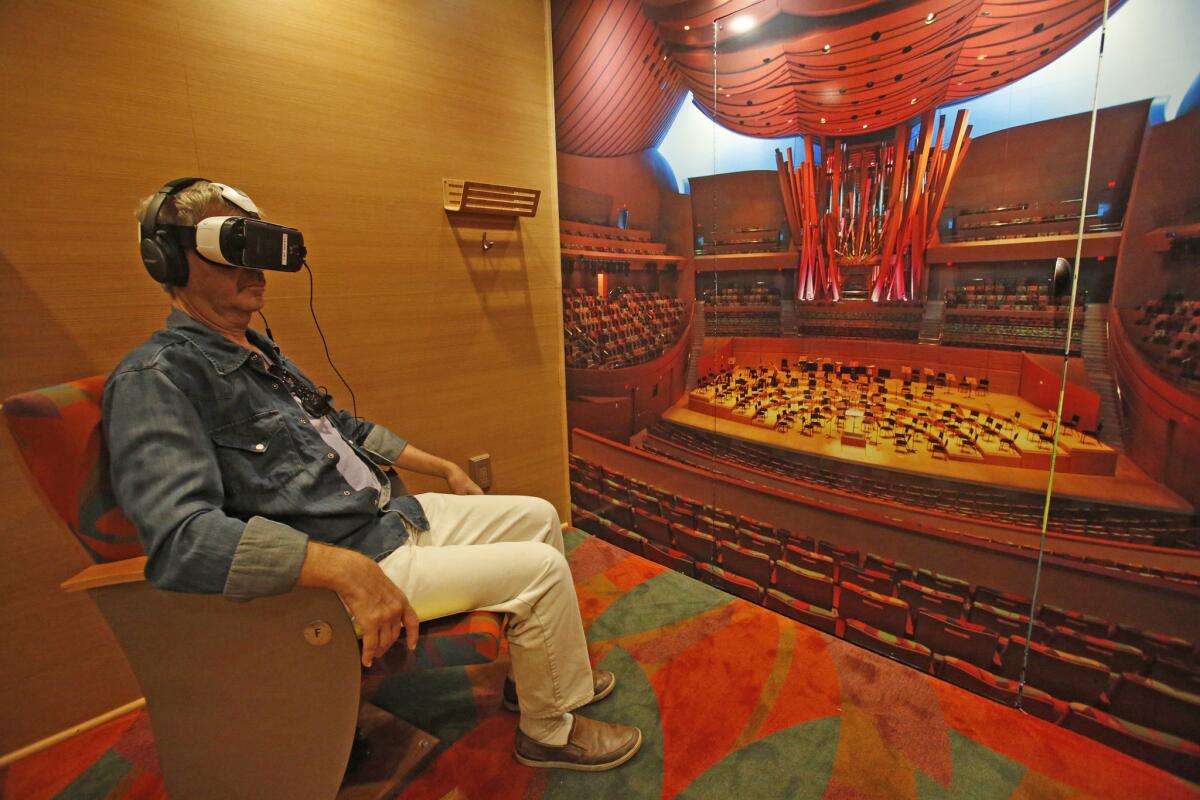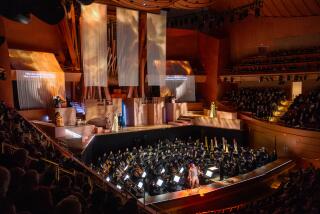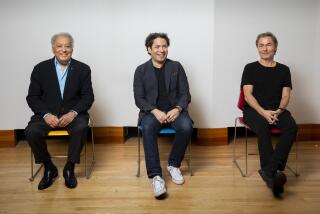L.A. Philharmonic’s Van Beethoven takes virtual reality for a classical spin

Neal Taylor watches and listens a Los Angeles Philharmonic performance via a virtual reality headset in the orchestra’s Van Beethoven.
Can the technology that set the video gaming world abuzz create classical music fanboys and girls?
The Los Angeles Philharmonic has launched a virtual reality project in which people don VR goggles and Samsung headsets that give them a 3-D, 360-degree experience of four minutes of Beethoven’s Symphony No. 5, performed by the orchestra at Walt Disney Concert Hall.
The VR goggles and other equipment were put aboard a bus, dubbed Van Beethoven, and sent out to tour the county through October.
The Phil is one of a select number of classical music ensembles around the world that have begun testing the VR waters.
SIGN UP for the free Essential Arts & Culture newsletter >>
“Honestly, it’s an experiment right now. We’re going to see how the city responds to it,” said Amy Seidenwurm, the orchestra’s director of digital initiatives. “It’s for people who don’t like classical music, to show them how it can be part of their life.”
Using the headsets, the viewer watches from the orchestra section of Disney Hall as conductor Gustavo Dudamel leads the L.A. Phil in the famous movement. Turning one’s head from side to side, or up and down, provides different views of the concert hall.
The perspective shifts partway through the performance so that the viewer is behind the orchestra, facing the conductor.
It was an Oculus application for Fox’s TV series “Sleepy Hollow,” in which users experience being decapitated, that persuaded the Phil to take the VR leap. The “Sleepy Hollow” app recently won a Creative Arts Emmy.
Shooting for the VR clip took place at Disney Hall in May, and took less than a day. Crews used two different camera rigs, each consisting of multiple GoPro digital cameras, to capture Dudamel and the orchestra performing the movement several times and at different angles.
Sound was especially important, with about 40 microphones placed around the concert hall to create more than just a surround-sound effect.
The goal was to capture sound as “it bounces around, and to create the audible sensory feeling of being there,” said Pietro Gagliano, a partner and executive creative director at Secret Location, the Toronto-based digital studio that worked with the orchestra on the project.
Users are able to detect subtle shifts in sound as they turn their heads to view different parts of the hall.
“We tried to have it emulate real life as much as possible,” he said.
In post-production, editors stitched together various camera angles of Disney Hall to create a seamless, 360-degree view of the venue. They also added “Fantasia”-like visual effects — colorful digital tracers that resemble fireworks — to punctuate the music.
In the future, “I would like to see a longer piece of music where you can decide what you want to watch and where you want to watch,” Seidenwurm said.
This summer, the Adelaide Symphony Orchestra in Australia initiated a VR concert series using Samsung headsets. The series — which consists of five pieces, including Sibelius’ “Finlandia” and Strauss’ “Blue Danube” — was captured during a live performance in May.
“We think it has enormous potential, not just from the point of view of audience development, which is a concern for all orchestras, but also for marketing and branding,” said Vincent Ciccarello, the orchestra’s managing director.
Headsets were made available to the public at the local headquarters of Santos, the Australian oil and natural gas company that is a longtime corporate sponsor of the orchestra and helped to fund the project.
The Adelaide orchestra teamed up with Jumpgate, an Australian virtual reality company that had worked in the tourism and sports spheres and was looking to expand into the cultural arena. The company captured the concert using a rig of 14 GoPro cameras in front of conductor Guy Noble, plus another camera in front of the musicians.
The L.A. Phil declined to say how much its VR initiatives cost, but said money came from an innovation fund established by board member David Bohnett, the L.A. technology entrepreneur and venture capitalist, as well as a grant from the Irvine Foundation.
Although orchestras are hoping young viewers will fall for the experience, one crucial age bracket won’t be able to test-drive it. Both Oculus and Samsung restrict their technology to people 13 years or older.
Menlo Park-based Oculus, which is owned by Facebook, has stated that the technology is still new and its effects on developing eyes remain unknown.
This was a disappointment to 8-year-old Adam Cohen, who visited the orchestra’s VR truck with his family on a recent weekend on Wilshire Boulevard near the L.A. County Museum of Art. (Future stops can be found at www.laphil.com/vanbeethoven.)
“I wish kids my age would be able to try it,” said the young student, who studies the piano.
His mother, Nazanin, described the application as “really cool,” while his dad, Alex, said it was impressive to “watch from the conductor’s angle and then the strings.”
Sukhun Kang said he’s not normally a big fan of classical music but thought the VR clip was different enough to make him consider attending a concert. It also helped that orchestra staff was giving away $20 gift cards toward concert tickets.
“Maybe,” he said, when asked if he would buy a ticket. “We’ll see what the price is after the discount.”
His wife, Hyekyung Shin, said she enjoyed the VR experience. “I liked being able to make eye contact with the conductor,” she said.
For now, the L.A. Phil has no concrete plans to follow up its VR initiative, saying it will wait for feedback from the current pilot program. The Adelaide Symphony said that it hopes to make VR part of a long-term project.
Other groups to toy with VR include the Sydney Opera House, which has partnered with Samsung to capture a pop concert by the Australian duo Flight Facilities.
Watching a concert in VR is both “experiential but solitary,” said Monica Seggos, who recently tried the L.A. Phil’s application.
“You’re not responding to the reactions of other people around you,” she said. But as a marketing tool, “this is something that would [grab] me. Not like a desk with people handing out brochures.”
Twitter: @DavidNgLAT
More to Read
The biggest entertainment stories
Get our big stories about Hollywood, film, television, music, arts, culture and more right in your inbox as soon as they publish.
You may occasionally receive promotional content from the Los Angeles Times.











